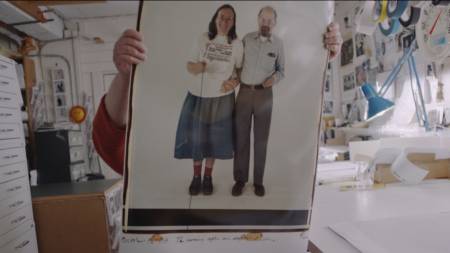-
THE B-SIDE: ELSA DORFMAN'S PORTRAIT PHOTOGRAPHY (Errol Morris 2016)
ERROL MORRIS: THE B-SIDE: ELSA DORFMAN'S PORTRAIT PHOTOGRAPHY (2016)

ELSA DORFMAN SHOWS A 20X40 OF HERSELF WITH GINSBERG IN THE B-SIDE
A casual portrait
Elsa Dorfman is an old lady of 79 and also a friend of Mr. Morris. They both live in Cambridge, Massachusetts. Of this film, an unpretentious gesture of a 25-year friendship, Morris said, in a NYFF Q&A, that with a subject like her "you just have to get out of the way," and for good or ill that is pretty much what he did. He lets Elsa ramble on, filming her in her garage-archive at a large drafting desk pulling out one photograph after another from ranks of flat files containing nearly fifty years of work, or decades anyway. Morris adds some illustrative material, but mostly his film is her talking and her work. So presented, it turns out to be thin material, and the 76 minutes feel like more than enough.
Two things are fascinating: a network of notables, artistic and intellectual, and a unique large view camera "instant" photographic format, doggedly pursued. Elsa, who married a civil rights lawyer, knew a lot of Beat era writers and poets as well as some rock stars and Harvard big shots,and was a good friend of Allen Ginsberg from his most creative period up to the end, and made many portraits of him, including huge nude ones. One of Morris' best ancillary moments is two phone messages from Ginsberg and a friend when he was about to die. The other thing is Elsa's long and faithful association with the big format Polaroid cameras, the 20x24 and the more rare 40x80, though she points out that to Polaroid she was no one special: other photographers got preferential access to the special cameras. It was only by persistence and renting a large space that she was able to have regular access to one of the cameras and use it to shoot paid portraits. Surely Richard Avedon's use of large format view camera portraits in his In the American West series blows Elsa's big Polaroid efforts away for artistry and drama, though he probably could never have achieved her funky down home charm either, and her work, though unpretentious, has a consistent positivity and warmth Avedon's attention-getting oddities lack. As she explains, she doesn't do unhappy people. Her arbitrary, thrown-together shots, however, despite their charm, don't set her with the great, penetrating artists of photographic portraiture.
Elsa's rambles provide a somewhat sketchy picture of her life, a job with Grove Press in the sixties, and other connections after she left New York that brought her in touch with Beats and other notables. Details, lacking here, are partly filled in by her Wikipedia bio, which says she organized a "Paterson Society" that gathered Beats and kept up a correspondence with them afterwards "as they traveled the world." Maybe she met more of them through Ginsberg, or even her husband; who knows? She managed to photograph Bob Dylan at a concert when others were excluded. She also is shown selling her (smaller) photos on the street from a cart; apparently her husband's civil rights expertise helped her evoke her Second Amendment rights against police harassment when doing this.
As with all photography just as a record of people and their times it is interesting to see Elsa's photographs, even the "B-side" ones, which she explains are those out of two big Polaroids made that clients chose not to keep, and left with her. A more efficient presentation might have included a panorama of them, carefully photographed; seeing Elsa manhandle and pull them out randomly adds little but a sense that there are many and she has not seen them for a long time. Learning more of what she has to tell would have taken a lot more interviews, edited into the best moments, and including a more complete picture of her life and of her relationships with the notables.
At the New York Film Festival presentation of the film, a special surprise was an appearance of Dan Stern, President of the Film Society of Lincoln Center, with one of the 20x40 Polaroid cameras he arranged the Society to buy, along with a stock of the necessary film and other supplies that Polaroid no longer makes. For some years now the FSLC has had several photographers do portraits of filmmakers and artists it has featured using the big camera. They are displayed in Film Society lobbies and hallways at the Walter Reade Theater and the new film center across the street. On this occasion the camera was set up for Elsa to shoot Errol, and the results were shown to the audience. But when all is said and done, as Walter Chaw also has commented from Telluride, Morris' portrait of Elsa Dorfman, while it has touching and exciting moments, is too careless an effort to rand with Morris' best work.
The B-Side: Elsa Dorfman's Portrait Photography, 76 mins., debuted at Telluride 4 Sept. 2016, also showed at Toronto, New York, Chicago. Screened for this review at the New York Film Festival.
Last edited by Chris Knipp; 10-10-2016 at 03:57 AM.
 Posting Permissions
Posting Permissions
- You may not post new threads
- You may not post replies
- You may not post attachments
- You may not edit your posts
-
Forum Rules





 Reply With Quote
Reply With Quote
Bookmarks